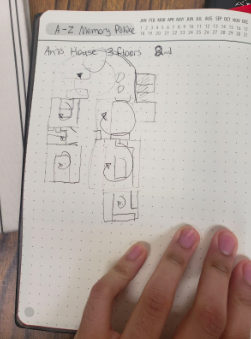Boost Your Dream Recall
One of the most frequent complaints we get from aspirational lucid dreamers is that they just can't remember their dreams in the morning.

You may be doing everything right, but still not getting results. To help solve this problem, we partnered with world renowned memory expert, Dr. Anthony Metivier. Dr. Metivier wrote a guest post for us to help WOLD readers solve this problem once and for all.
We also recommend checking out his free memory improvement kit and his memory masterclass, which includes a module specifically designed for dream recall.
The Hidden Key to Lucid Dreaming: "Automated" Dream Recall
What if you could triple the amount of times you lucid dream?
Even better, what if you were able to deepen and lengthen each experience?
The good news is that you can.
All it takes is a simple exercise in memory. One that provides many other benefits too, such as never forgetting a name that appears either in a dream or in waking life.
Ready?
Let’s dive in!
What Is Automated Dream Recall?
You’ve probably heard that writing down your dreams will increase how often you lucid dream.
This is true, and procedural memory explains why.
In brief, it’s exactly like the way you “know” how to ride a bike without thinking about it thanks to procedural memory. When you write down your dreams regularly, your brain treats it like a procedure. You start remembering dreams much more automatically.
What if you currently don’t recall your dreams?
Go ahead and keep a dream journal anyway. Writing down “I don’t remember any dreams” has been known to start prompting dream recall because establishing the procedure causes you to reflect on the process.
Indeed, scientists find dream reporting an absolute must for memory formation.
Add A Memory Palace For Your Dreams
I once journaled my dreams without pause for six months. It was essential for establishing regular lucid dreaming experiences.
But getting up to write down multiple dreams per night was ultimately not sustainable.
I knew about the Memory Palace technique, so I started to experiment with it.
Basically, a Memory Palace is a mental reproduction of a familiar location. It helps you recall information by imaginatively laying out associations along a journey. These associations help trigger your recall of information.
I can still remember dreams I had decades ago thanks to this technique.
For example, I can think back to the upper right ceiling corner of a room in Western Germany and remember a crazy prism-like volcano pulsing its heat into the sand beneath my feet.
It’s easy to remember because I intentionally placed a version of the core image in that corner. Then, mentally moving to the next ceiling corner, I placed an image to help me remember the next dream.
Note that I still wrote down the dreams in my dream journal later. But thanks to this technique, I was able to remain laying in bed, quickly memorize the dream and go back to sleep, confident that I’d still recall it later.

How to Create Your First Dream Memory Palace
I suggest that you sketch out the Memory Palace you’re going to use. This simple step will help you plan the journey you will use. That way, you don’t have to think about it while you’re using the Memory Palace technique.
Please note that I’m not talking about high art here. Here’s an example from one of my students in a journal optimized to capture the exact dates in the dream recall journey:

Once you have your drawing, for the first week or two, refer to it as you write down your dreams.
Mentally project exact imagery from the dream or associations that will help you remember the dream into your Memory Palace.
For example, my prism dream was wild enough to serve directly as an image without association.
But pretending that it didn’t, I could use Pink Floyd’s iconic Dark Side of the Moon album cover as an association that would trigger the target dream scenario.
Finally, as you move throughout the day, refer back to the Memory Palace a few times. This will do two things:
- Establish procedural memory for using the technique itself.
- Help the dream material enter long term memory.
Do You Have to Remember Your Dreams Forever?
Not at all. There are dreams I really want to hold onto and I revisit them repeatedly to keep them sharp.
But usually I use the technique to make sure I can remember the dreams when I wake up formally and get them into my dream journal. This procedure lets you use Memory Palaces for other things like learning a language or passing exams.
The benefit of combining journaling with dream memorization is that you give yourself more ways to interact with your dreams.
The more you combine these two approaches, the more you’ll consistently trigger lucid dreaming.

Deepening the Dream Recall Experience
Here’s another tip as you explore this dream recall strategy:
When you remember a dream and re-experience it in memory, use a personal mantra like, “Deepen, deepen.”
Meditation expert Shinzen Young has explained the science behind why creating a feedback loop like this works in the context of producing ecstatic states of meditation.
You don’t have to think or say, “Deepen, deepen.” Many variations will do. The point is to experience-observe-label-intentionally enrichen the experience.
This simple step will also potentially increase more incidents of lucid dreaming.
And now you have the tools needed to remember as many of those experiences as you wish while experiencing them more completely. Almost as if on autopilot.










